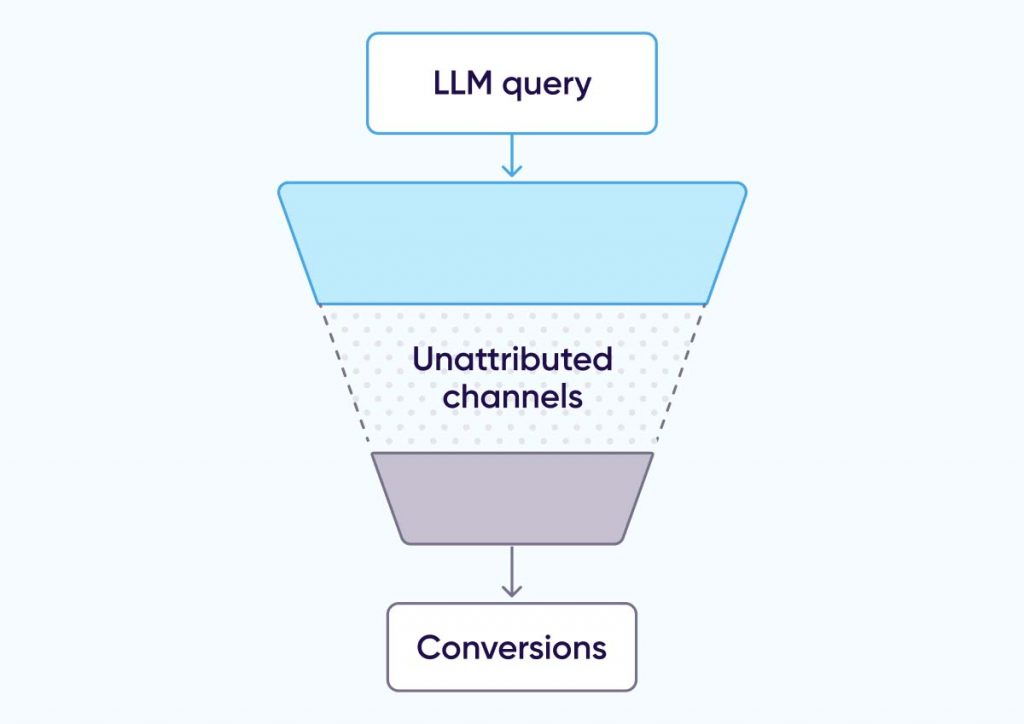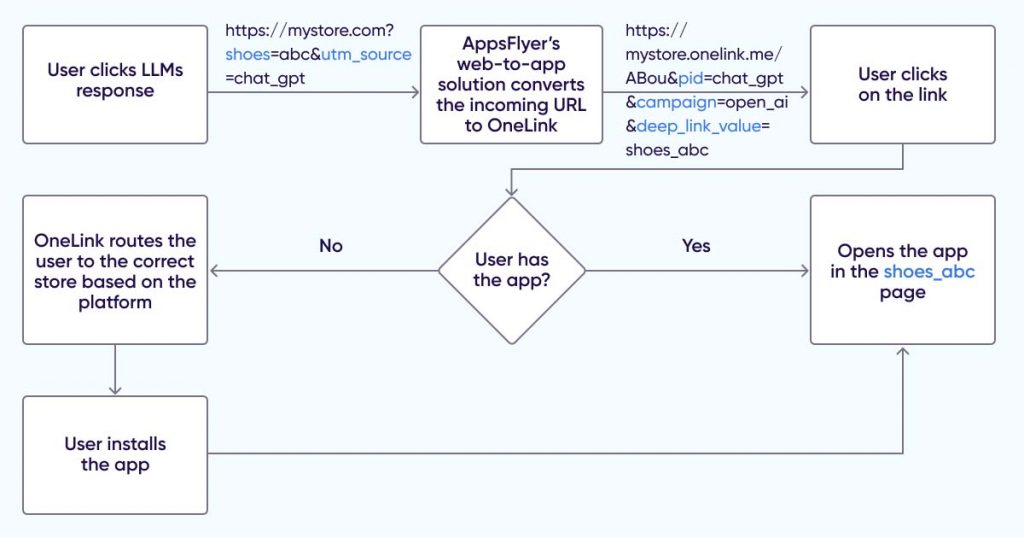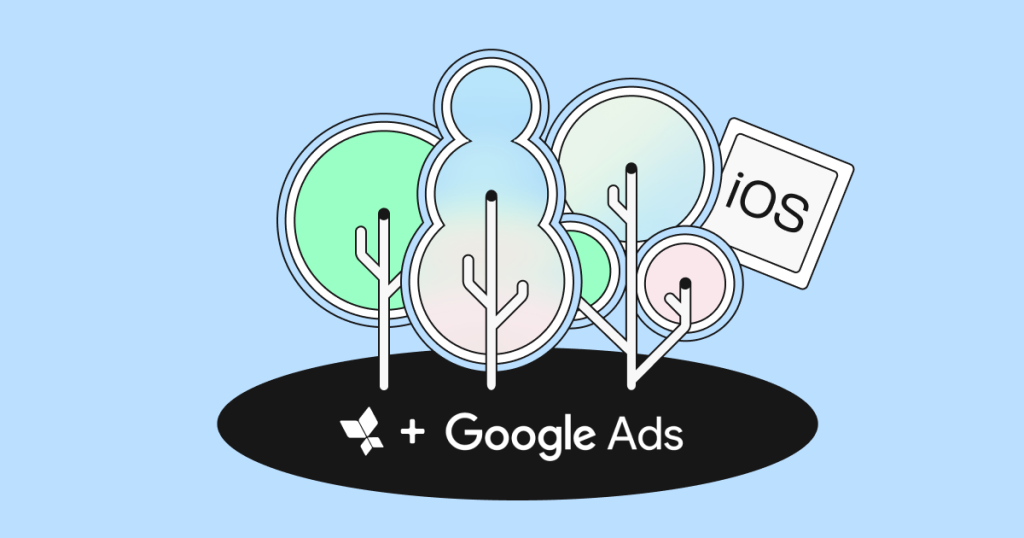Measuring the unmeasurable: Attribution in the age of GenAI


As ChatGPT, Gemini, Claude, and other Large Language Models (LLMs) increasingly become the go-to source for answers, marketers are entering a new organic (and potentially non-organic) frontier, one where traffic originates from AI responses, not search engine result pages.
LLMs are not only transforming how users discover apps and content but also impacting consumer behavior. Recent research shows that users who engage via LLMs have higher intent and monetize better than search users. The conversational format feels like a soft recommendation rather than a sales pitch, driving stronger user intent.
However, it also surfaces new challenges: How do you influence, measure, and optimize discovery in these environments?
In this blog, we unpack how GenAI and LLMs like ChatGPT, Gemini, and Claude are reshaping discovery — and what it means for marketers. You’ll see which industries are leading the shift, why attribution is breaking, and how to turn AI-driven traffic into measurable growth.
AI-First industries: Who’s leading the shift?
LLMs are already delivering meaningful traffic to brands, but often without marketers realizing it because the traffic goes unattributed.
Based on these market trends, some industries are seeing a deeper impact:
- Legal & Financial Services: Users ask complex, trust-intensive questions that LLMs are best equipped to answer.
- Online shopping: LLMs drive traffic to retail and e-Commerce sites based on product page information. In fact, OpenAI has just announced its on-site checkout process which may reduce their website traffic and allow in-chat experience for completing the transaction.
- Healthcare & Insurance: AI chat becomes the first line of inquiry for symptoms, treatments, and coverage.
- SMB & SaaS: App discovery, product comparisons, and usage walkthroughs often show up in AI answers.
- Consumer Tech: Users rely on conversational AI for product reviews and recommendations.
In many cases, AI is now a more common entry point than traditional search, with some brands seeing 5–10% of top-of-funnel traffic driven by LLMs, even when not labeled as such in analytics.
The challenges of optimizing for LLMs
Unlike traditional SEO, LLM visibility is harder to crack and even harder to measure.
There are three core challenges:
- No visibility into rankings: You can’t “rank check” a ChatGPT response. There’s no way to know how often you’re cited.
- Inconsistent linking: Some models link, some don’t. Others paraphrase your content without attribution.
- Attribution is broken: Many AI clicks show up as organic traffic, obscuring the true source in analytics tools.
Together, these gaps make AI optimization feel like you’re flying blind.

How to measure the impact of AI
To overcome these challenges, brands must adapt their content and measurement strategies:
- Write for AI: Prioritize concise, clear answers. Use questions, summaries, and bullets. Repeat keywords multiple times. Treat your content like it might be quoted out of context. Things that work well include pricing tables, integration breakdowns, trial proposals, product walk-throughs, comparison pages, and so on.
- Track proactively with UTMs: Use UTM parameters on URLs likely to be picked up by LLMs, such as forums, docs, partner content, and public knowledge bases.
- Bridge the visibility gap with web-to-app attribution flow: Turn invisible clicks into measurable insights. If you can attribute the users in your app or website to an LLM engagement, you will be able to understand and optimize the user journey based on lower funnel actions.
- Use deep links wherever possible in your owned and earned media: LLMs collect data from social networks and across the web. When you place links in these placements, make sure they’re deep linking into the app so that, if a user has the app, they’ll have a contextualized and seamless experience — resulting in higher engagement and conversions. Examples include your website, social group links, YouTube videos, influencer campaigns, referral programs, affiliate links, bio pages, and more.
Note: deep linking can be complex, so make sure you use the right tool for it (more on this in the next section).
- Use website schema markup: Structured data helps LLMs understand and cite your content correctly. For example, adding FAQPage or Product schema in JSON-LD format can boost discoverability in AI-generated answers.
👉 This markup should be placed in the HTML of your site — typically in the <head> or at the bottom of the <body>.
Example:
<script type="application/ld+json">
{
"@context": "https://schema.org",
"@type": "FAQPage",
"mainEntity": [{
"@type": "Question",
"name": "What is the best budgeting app for freelancers?",
"acceptedAnswer": {
"@type": "Answer",
"text": "BudgetPro helps freelancers manage cash flow, taxes, and savings through smart automation."
}
}]
}
</script>
AppFlyer’s OneLink: What is it and how can it help?
OneLink is AppsFlyer’s deep linking and redirection solution. It solves a complex problem, the result of multiple combinations of where a link can be placed on the Internet and what happens when you click on it, which depends on factors such as the platform, OS version, browser, app, and others.
For example, some browsers open apps directly while others require a fallback. For your app, you might want existing users to open the app directly and new users to go to the App Store. You need to differentiate between these two groups.
OneLink abstracts all this logic and ensures that once a link is clicked, it always works. And on top of that, it measures the parameters you set up on the link upon creation. That is the reason it is a great option to solve the LLM challenges:
- Deep link as many users as possible to the app.
- Measuring the results of web-to-app user journeys.
Deep link users into the app using OneLink EVERYWHERE
You want LLM to use your deep links. The main reason is that you get high-quality traffic for free without any extra hop in the user journey. To do so, you should spread your link publicly in any Owned or Earned Media channel you have. Some examples can be your website, social groups links, influencer campaigns, referral programs, and links you share with affiliates, bio pages, and the like.
When you use OneLink in these placements, you’re buying yourself insurance that no matter who the user who clicks on the link is, and where it is placed, the user gets the right behavior. Be it opening the app (optimal), or installing the app, and after navigating to an in-app content based on the deferred deep link value. That is another parameter that the link carries and is being passed back to the app after installation, so that the app knows to tailor the first-time user experience.
Ultimately LLMs prefer OneLink because of its robustness rather than a simple iOS Universal Link or a URI scheme. With OneLink, it understands that it can handle multiple experiences.
Web-to-app with OneLink: Turning AI mentions into measurable conversions
AppsFlyer’s OneLink also solves the attribution problem for AI-generated traffic in web-to-app flows, which are very common in the app industry.
Here’s how it works:
- User asks an AI assistant for a recommendation. For example, “What is the best personal finance app for freelancers?” The LLM replies with your link.
Incoming URL: https://your.website.com?utm_source=chatgpt.com
- User clicks on the link. OneLink uses a Smart Script or Smart Banner on your site to translate the incoming URL params into an attribution link and places it behind a OneLink that is agnostic to the platform, browser and OS.
Generated OneLink: https://yourapp.onelink.me?pid=chatgpt
- Once the OneLink is clicked, it:
- Sends existing users directly into the app to a specific in-app content based on their LLM searches.
- Routes new users to the correct app store by identifying their device, OS, browser, and platform.
- Measures the source that led the user to install or open the app, in this case, the LLM tool.
- Sends existing users directly into the app to a specific in-app content based on their LLM searches.

This data is available in AppsFlyer’s raw data reports for analysis and optimization purposes. Now you can look at your funnel, compare the performance of the LLM with other LLMs or with other owned and earned channels, and invest the resources where it makes sense.
The bottom line
LLMs are fast becoming the new gateway to content, apps, and products. However, they also bring uncertainty in visibility, traffic source, and user intent.
To succeed, marketers must:
- Treat LLMs like a new organic channel
- Use deep links and a deep linking solution to measure their effectiveness
- Use structured content and schema markups
- Tag AI-discoverable links with UTMs
GenAI is wide open. With the right setup, you can stop guessing, start measuring, and optimize a critical part of your business.







